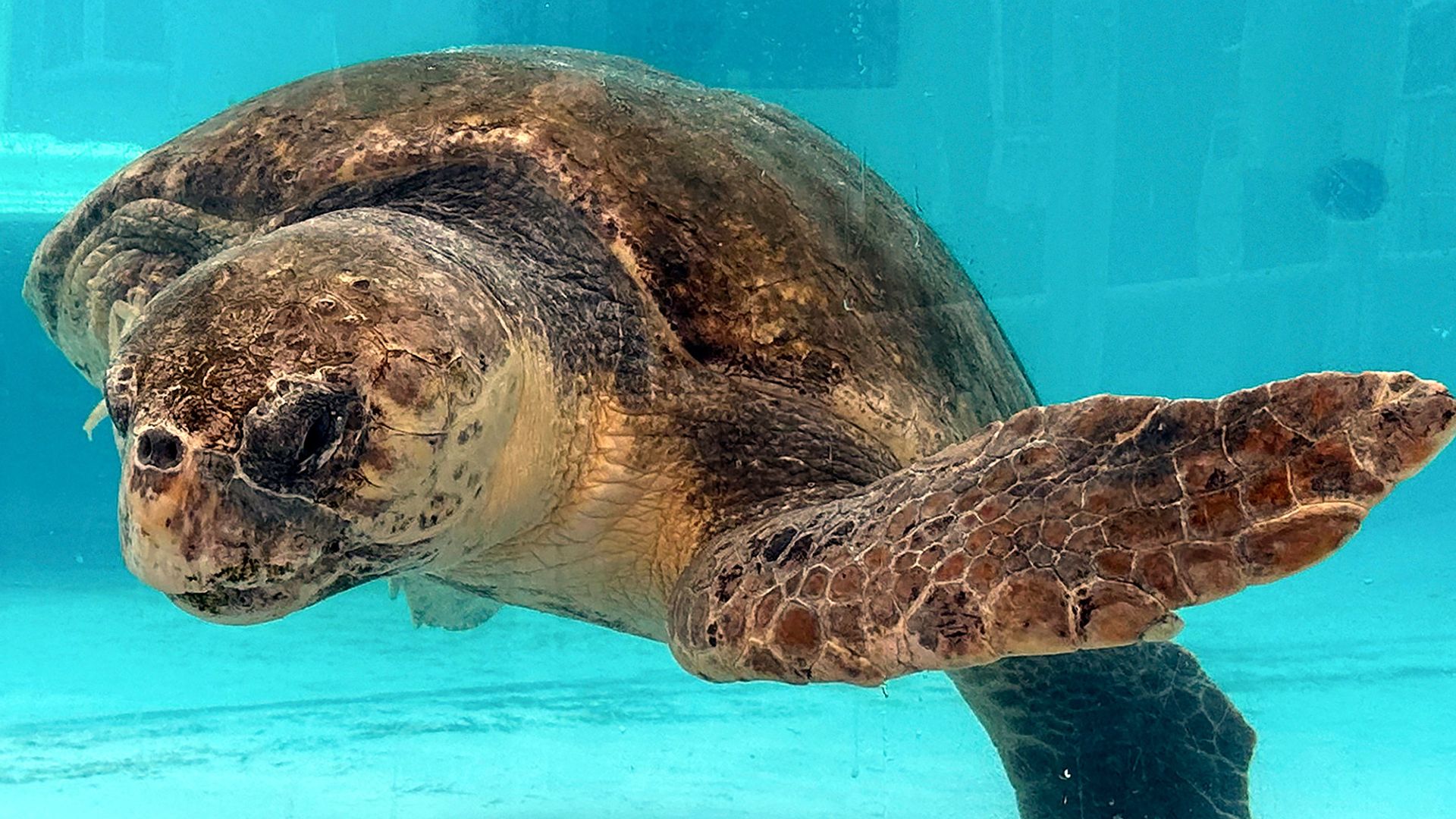
Media Miss: Sea turtle nest numbers up in US amid climate change concerns
By Shannon Longworth (Reporter), Alex Peebles (Producer), Zachary Hill (Editor)
Media Landscape
See how news outlets across the political spectrum are covering this story. Learn moreBias Distribution
Left
Right
Untracked Bias
Despite climate change worries, sea turtles are breaking records as biologists in the U.S. report discovering the most nests since 2016. On beaches in Florida, preliminary reports recorded more than 133,840 loggerhead turtle nests and 76,500 green turtle nests.
So particularly with climate change, reproductive output of all of these nests is actually quite low compared to what it should be.
Justin Perrault, Loggerhead Marinelife Center
This story is considered a blindspot for right-leaning media outlets, as the Straight Arrow News Media Miss™ tool shows the majority of outlets covering it are left-leaning.

Download the SAN app today to stay up-to-date with Unbiased. Straight Facts™.
Point phone camera here
SAN’s real-time Media Miss™ tool spotlights which stories right-leaning and left-leaning outlets aren’t covering to provide a complete picture of the news.
The record numbers are not limited to Florida beaches; other states, like South Carolina, North Carolina, Alabama and Georgia, have also seen a rise in nests this year, as female turtles made their slow journey up beaches, like they have done for millions of years to lay their eggs.
The increase in nests comes despite climate change piling onto the already challenging nesting process. Justin Perrault, the director of research at the Loggerhead Marinelife Center, told the Associated Press that the world’s sea turtles aren’t out of the sand–er, woods–yet.
“You’ve got habitat loss and sea level rise and coastal armoring, a lot of these things that have come up pretty heavily in that last several decades that the turtle now has to combat,” Perrault said. “So particularly with climate change, reproductive output of all of these nests is actually quite low compared to what it should be.”
Roughly one in every 1,000 sea turtle hatchlings makes it to adulthood. A turtle’s journey from its nest to the ocean is already riddled with threats from humans and predators. For instance, hatchlings use the moon to navigate to the water, and light pollution from streetlights and hotels can confuse them and point them in the wrong direction.
While biologists are concerned that climate change will continue to threaten sea turtles in the future, warmer temperatures have already affected the species for years. Sand temperatures play a direct role in the gender of hatchlings, and more heatwaves in Florida over the past few years have made the sand warmer, leading to a gender imbalance.
According to a manager at a turtle hospital in Florida, an Australian study found that nearly 99% of new turtle hatchlings are female.
Unbiased news.
Directly to your inbox. Free!
Learn more about our emails. Unsubscribe anytime.
By entering your email, you agree to the Terms & Conditions and acknowledge the Privacy Policy.
As temperatures rise globally, a study by a Florida State University professor found that turtles will have to start nesting much earlier or much later than normal. Though nesting rates are up this year, the fear, according to the study, is the climate may be changing too quickly for the turtles to evolve and survive as a species.
Straight Arrow News strives to provide unbiased, fact-based news in addition to offering a comprehensive look at how the media is covering stories that matter most. Learn more about the Media Miss™ tool and decide for yourself.
[SHANNON LONGWORTH]
DESPITE CLIMATE CHANGE WORRIES, SEA TURTLES ARE BREAKING RECORDS AS BIOLOGISTS SAY THEY HAVE DISCOVERED THE HIGHEST NUMBER OF NESTS SINCE 20-16.
THIS STORY IS CONSIDERED A BLINDSPOT FOR RIGHT-LEANING MEDIA OUTLETS AS THE STRAIGHT ARROW NEWS MEDIA MISS TOOL SHOWS THE MAJORITY OF OUTLETS COVERING IT ARE LEFT-LEANING.
OUR REAL-TIME MEDIA MISS TOOL SPOTLIGHTS WHICH STORIES RIGHT-LEANING AND LEFT-LEANING OUTLETS AREN’T COVERING SO YOU GET A COMPLETE PICTURE OF THE NEWS. THIS IS HOW THE NEWS SHOULD BE, FAIR, FACTUAL AND UNBIASED.
[Mote Marine Laboratory & Aquarium]
“2023 was our fifth highest nesting season that we have had in our 42 years of monitoring sea turtle nests in Sarasota County.”
[Melissa Macksey]
THE RECORD NUMBERS ARE NOT LIMITED TO SARASOTA FLORIDA BEACHES.
IN FLORIDA ALONE, FEMALE TURTLES MADE THEIR SLOW JOURNEY UP BEACHES, AS THEY HAVE DONE FOR MILLIONS OF YEARS, CREATING MORE THAN 200,000 NESTS BETWEEN TWO SPECIES.
OTHER STATES, LIKE SOUTH CAROLINA, NORTH CAROLINA, ALABAMA AND GEORGIA HAVE ALSO SEEN A RISE IN NESTS THIS YEAR.
DESPITE CLIMATE CHANGE PILING ONTO THE ALREADY CHALLENGING NESTING PROCESS.
Justin Perrault: “You’ve got habitat loss and sea level rise and coastal armoring, a lot of these things that have come up pretty heavily in that last several decades that the turtle now has to combat. So particularly with climate change, reproductive output of all of these nests is actually quite low compared to what it should be.”
[SHANNON LONGWORTH]
ONLY ABOUT ONE IN EVERY 1,000 SEA TURTLE HATCHLINGS MAKES IT TO ADULTHOOD.
THEIR JOURNEY FROM THEIR NESTS TO THE OCEAN IS ALREADY RIDDLED WITH THREATS FROM HUMANS AND PREDATORS.
HATCHLINGS USE THE MOON TO NAVIGATE TO THE WATER, AND LIGHT POLLUTION FROM STREET LIGHTS AND HOTELS, CAN CONFUSE THEM,
AS TEMPERATURES RISE GLOBALLY — A STUDY DONE BY A FLORIDA STATE UNIVERSITY PROFESSOR FOUND THAT TURTLES WILL HAVE TO START NESTING EITHER MUCH EARLIER OR MUCH LATER THAN NORMAL.
SO, WHILE NESTING RATES ARE UP THIS YEAR. THE FEAR — ACCORDING TO THE STUDY — IS THE CLIMATE MAY BE CHANGING TOO QUICKLY FOR THE TURTLES TO EVOLVE AND SURVIVE AS A SPECIES.
Media Landscape
See how news outlets across the political spectrum are covering this story. Learn moreBias Distribution
Left
Right
Untracked Bias
Straight to your inbox.
By entering your email, you agree to the Terms & Conditions and acknowledge the Privacy Policy.
MOST POPULAR
-
 Getty Images
Getty Images
Judge allows CNN lawsuit potentially worth billions to continue
Read16 hrs ago -
 Reuters
Reuters
It’s a bird, it’s a plane, it’s the first video of Alef Aeronautics’ flying car
Watch 2:1318 hrs ago -
 Getty Images
Getty Images
Democrats in Congress receive lowest approval rating in Quinnipiac poll history
Watch 2:5919 hrs ago -
 Getty Images
Getty Images
AG Bondi reviewing Epstein documents for release, could hold client list
Watch 1:4819 hrs ago




